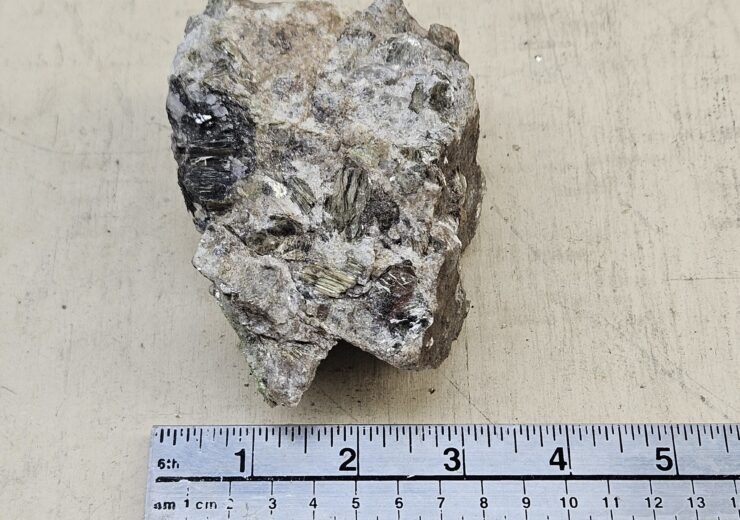Orford Mining is a gold and critical mineral explorer focused on highly prospective and underexplored areas of Northern Quebec

KWatt LCT-bearing enriched pegmatite grab sample. (Credit: CNW Group/Orford Mining Corporation)
Orford Mining Corporation (“Orford”) (TSXV: ORM) is pleased to announce that assay results from its recently completed exploration program on its Nunavik Lithium Properties (Figure 1) confirm the occurrence of Lithium-Cesium-Tantalum (“LCT”) bearing pegmatites. During this initial exploration program, a total of 1,534 field stations and 489 samples of pegmatite were collected across Orford’s expanded and 100% owned, 557 km2 of Lithium Properties in the prospective Cape Smith area of the Nunavik Region in northern Quebec. Results from the assays indicate the occurrence of LCT bearing pegmatites on three properties: kWatt (Figure 2), Flare and Cathode (Figure 1, Table 1 The presence of these rare element pegmatites (LCT) on its Nunavik Lithium properties are consistent with the last stages of the most fractioned granitic crystallizations where concentrations of critical metals such as lithium deposits may occur. The discovery of these dykes will help Orford vector its future exploration efforts.
David Christie, President and CEO of Orford, commented, “The success of Orford’s inaugural exploration program on its 100% owned Nunavik Lithium Properties is a testament to our rigorous ground selection process and to our hardworking field teams. Discovering new LCT Pegmatite fields in this totally unexplored region is a huge step forward, giving us a solid foundation upon which to build a 2024 program.”
Highlights of the 2023 Field Season Confirms Greenfield Lithium Pegmatite Vectors:
Regional metamorphic grade: upper greenschist / lower amphibolite.
Occurrence of peraluminous granite and leucogranite on Orford’s Lithium Properties.
Key minerals identified in pegmatite indicative of proximity to fertile parent granite: green muscovite (+/- garnet, tourmaline, fluorite).
Assays indicate pegmatites are enriched in lithium, beryllium, tantalum, cesium, and rubidium
LCT-bearing pegmatites on at least 3 properties (Figure 1, Table 1) suggests high prospectivity for additional dykes.
Opportunity to generate additional targets and provide geochemical vector towards mineralization (more fractionated LCTs) using till assay data (results outstanding).
Orford has leveraged its competitive advantage in the region based on multi-year local operational experience and logistical preparedness which includes access to its centrally located camp, airstrip and fuel reserves. This has helped lead to the discovery of lithium anomalous dyke swarms on three of the Nunavik Lithium Properties. These dykes are up to 40 m-wide and can be traced for several kilometers. They contain variable green muscovite, tourmaline, +/- garnet, beryllium and apatite and, based on this mineralogy, plot within the field of prospective pegmatites (Figure 3). All grab sample assays have been received and enriched LCT pegmatites have been confirmed on kWatt, Flare and Cathode properties (Table 1). LCT enrichment is defined by the following concentrations in ppm which are values greater than Cs>30, or Ta>20, or Li>100, or Rb>1000, or Sn>30, or Ga>20, which represent a magnitude larger than Fertile Granites. Overall, field station and sampling density is less than three field stations and one sample per one km2, which offers the potential for significant discoveries after the 2023 preliminary work which has confirmed Lithium Pegmatite prospectivity.
An additional 550 till (frost boil) samples have been collected on the Radiant, kWatt and Wire properties to possibly identify “blind” LCT pegmatite which are not exposed at surface. Till assays results are expected at approximately the end of November and may identify additional targets for follow up. The till sampling was done in areas where there is strongly anomalous lithium in lake bottom sediment sample surveys completed by the Quebec government survey previously.
Table 1: Assay Values for Enriched LCT Pegmatites from Grab Samples Compared to Background and Fertile Granites. Note that grab samples are selective by nature and values reported may not be representative of mineralized zones. Number of Samples on each property: Cathode=30, kWatt=213, Flare=117.
Source: Company Press Release
